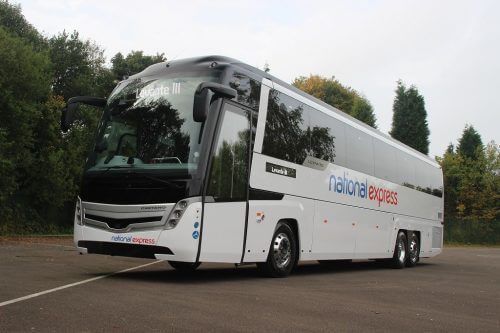
Gareth Evans reports on the plethora of features aboard National Express’ new Caetano Levante III body, which was unveiled at the Portuguese bodybuilder’s Leicestershire dealership last week
National Express UK Coach (NX) unveiled its new Levante III coach body at Caetano’s UK headquarters near Coalville, Leicestershire on Wednesday (September 27). The striking new vehicle will shortly enter service with Edwards Coaches and more immediately will be displayed on Caetano’s stand at the Coach & Bus UK show at the NEC this week. While this example is based on Volvo’s B11R chassis, a Scania-based variant will be heading to the UK from Caetano’s Portuguese factory in the coming weeks.
Background
“We started this project in 2015,” explained Richard Ball, Head of Engineering at NX UK Coach. “At that time, we were working with Richard Hunter, CEO of Caetano UK on a number of secret projects – including the Boa Vista double-decker.
“We’d already got an ongoing project that we were calling ‘safe & light’ which was about improving the safety of our customers. With Richard and his team’s help, we’ve done a lot of work to mitigate the increasing weight that was mandated by Euro 5 and 6 – and replacing it with components that were both stronger and lighter. We were looking out for new products that were coming into the market which we felt could help us and also things we felt could help improve life for the driver and customer alike. Our business is moving people safely and economically – we have to make a coach which does that. Once we’d started this project, we got a number of stakeholders together. Effectively, we had a big wish list of things we really wanted to cover – including aesthetics, safety, customer comfort and others were purely about design. At each point during the process, we were trying to make iterative changes.
“We tried to make a change that we could develop and understand what the output of that change was, so we could feed back again – it was a constant loop. Some of the things that are on this vehicle such as the seats, we’ve tested in the double-decker. Although trimmed differently in the double-decker, they’re the same model of Politecnica seats. Similarly, we removed 240V sockets and replaced them with double USBs on each seat. Again, the genesis of that was in the double-deck product.” […]
By subscribing you will benefit from:
- Operator & Supplier Profiles
- Face-to-Face Interviews
- Lastest News
- Test Drives and Reviews
- Legal Updates
- Route Focus
- Industry Insider Opinions
- Passenger Perspective
- Vehicle Launches
- and much more!


